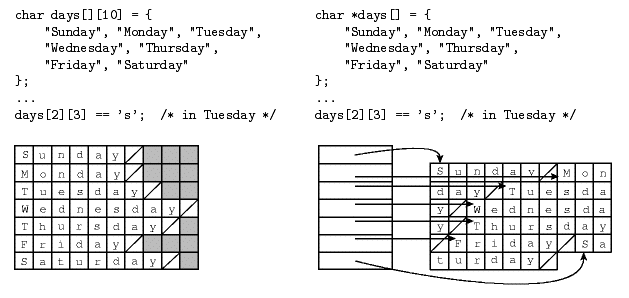TYPE Matrix_4x4_type
IS
ARRAY(1..4, 10..13) OF Integer;
ARRAY(1..4, 10..13) OF Integer;
- Fortran 77
- Global or automatic array (value model) variable in C:
-
int arr [ 40 ];
void cFunction (int size ) {
int
marbles [size][size/2];
}
}
When and where does array allocation take
place?
- Storage only on the heap
- Arrays are objects
-
String [ ] sArray = new String[5];
Object [ ] myArray = new Object [sArray.length];
- Java does do range checking. All arrays have a field length
that never changes.
- C, C++ can also dynamically allocate storage from the heap.
- C, C++ does not do range checking.
- Perl:
- variables names for arrays begin with "@"
- storage is dynamically allocated
- example:
- Extends the array to length 26.
- Arrays in most language implementation are stored in contiguous location in memory.
- Some languages arrays of arrays.
@myPerlarr = ("one","two","three");
$myPerlarr[0] is the scalar with value "one"
@myPerlarr[26] = "wow";
How is the array stored in memory?
Runtime calculation of array element.

- Left declaration is a true two-dimensional array.
- Right declarations is an array of pointers to array of chars.
- What are the trade offs?
- A:
array [LowerBound .. UpperBound]
- Let ba be the base address of array A, and
- Let size be the number of addressable units(bytes) required to store a value of base type of A.
- Then the effective address of A[k] is:
- Initialization: In FORTRAN, Java, C and Ada, arrays can be initialized in their declaration.
- Forcing a '2 dimensional' array representation with initialization in Java:
Can arrays be initialized when they have their storage allocated?
double[ ] [ ] identity = {
{ 1.0, 0.0, 0.0 },
{ 0.0, 1.0, 0.0 },
{ 0.0, 0.0, 1.0 }
};
- Note: "global" variables in Java are initialized (0,nil) but NOT local variables.
Haskell, Prolog
- Do not have arrays.
- lists are the way to sequence data.
- How are lists different from arrays?
- Programming in C++, C# and Java you should use collection frameworks provided in the languages.
Pointers:
- C, C++ pointer types
- polymorphic data types
- the R-value is an address
- int * x;
- float * y;
- C pointers' "units" are adjusted according to the size of the type they point to.
main(){
char* ptChr =0;
short* ptShort =0;
long* ptLong =0;
int i;
printf(" Index Char Short Long\n");
for ( i =0; i < 6; i++) {
printf("Offset of Pointers %d %d %2d %2d\n",
i, ptChr+i, ptShort+i, ptLong+i);
}
}
char* ptChr =0;
short* ptShort =0;
long* ptLong =0;
int i;
printf(" Index Char Short Long\n");
for ( i =0; i < 6; i++) {
printf("Offset of Pointers %d %d %2d %2d\n",
i, ptChr+i, ptShort+i, ptLong+i);
}
}
~>
Index Char Short Long
Offset of Pointers 0 0 0 0
Offset of Pointers 1 1 2 4
Offset of Pointers 2 2 4 8
Offset of Pointers 3 3 6 12
Offset of Pointers 4 4 8 16
Offset of Pointers 5 5 10 20
Index Char Short Long
Offset of Pointers 0 0 0 0
Offset of Pointers 1 1 2 4
Offset of Pointers 2 2 4 8
Offset of Pointers 3 3 6 12
Offset of Pointers 4 4 8 16
Offset of Pointers 5 5 10 20
- C++ allows functions to return l-values
-
int a[10];
int& f(int I) { return (a[I]); }
f(5) = 17;
// This assigns 17 to a[5]
- Pointer (access) types provide a way of manipulating memory addresses.
- Pointers may be used to create recursive types, e.g. linked list and trees.
- C example:
typedef struct tree {
int val;
struct tree* right;
struct tree* left;
}
Pointers and Arrays in C
- There is a close correspondence between types "array of Ttype"
and "pointer to Ttype".
- a[i] can be defined as *(( a )+( i ))
- In fact a[i] is the same as i[a]!
- Since ip = a; is legal is a = ip; legal?
int a[10], *ip;
ip = a;
ip = &a[0];